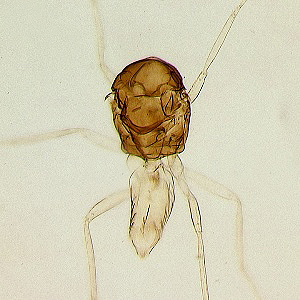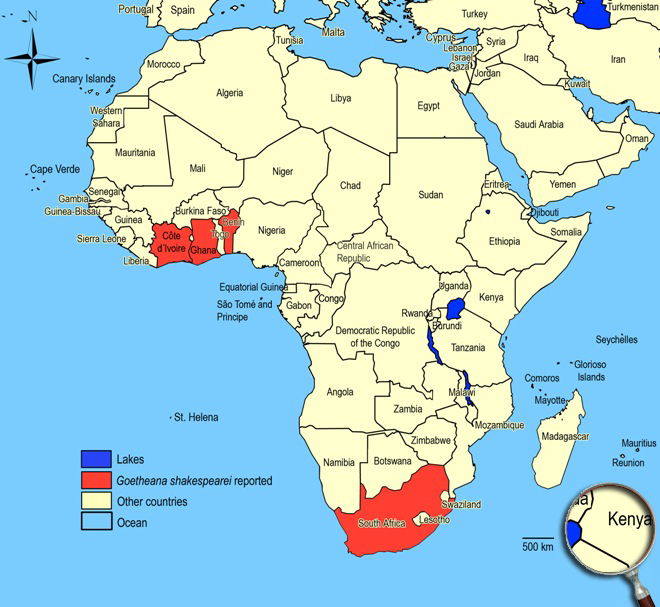Adamson AM (1936). Progress report on the introduction of a parasite of the cacao thrips from the Gold Coast to Trinidad, B.W.I. Tropical Agriculture. 13 (3): 62-63
Ananthakrishnan TN (1984). Bioecology of thrips. Indira Publishing House, Oak Park Michigan, USA, 233 pp
Annecke DP (1962). The genus Goetheana Girault in South Africa (Eulophidae - Hymenoptera). South African Journal of Agricultural Science. 5 (2): 273-279
Bartlett K (1937). The introduction and colonization in Puerto Rico of beneficial insects. Agricultural Notes, Puerto Rico Experiment Station. 75: 1-8
Bartlett K (1939). The introduction and colonization in Puerto Rico of Dasyscapus parvipennis Gahan, a parasite of thrips. Agricultural Notes, Puerto Rico Experiment Station. 87: 1-5
Beattie GAC & Jaing L (1990). Greenhouse thrips and its parasitoids in coastal New South Wales. General and Applied Entomology. 22: 21-24
Bennett FD (1970). Report on a visit to Jamaica, to collect stocks of the thrips parasite Goetheana (Dasyscapus) parvipennis July 1970. International Report CIBC, Ascot, UK, 3 pp
Bennett FD & Alam MM (1974). Report on a visit to Jamaica, mainly to collect egg parasites of Exophthalmus spp. for trials against Diaprepes abbreviatus (L.) in Barbados. CIBC-Trinidad, unpublished report, 5 pp
Bennett FD & Baranowski RM (1982). First record of the thrips parasite Goetheana parvipennis (Gahan) (Eulophidae: Hymenoptera) from the Bahamas. The Florida Entomologist. 65 (1): 185
Bennett FD, Glenn H & Baranowski RM (1993). Goetheana shakespearei (Hymenoptera: Eulophidae) an immigrant parasitoid of thrips in Florida and Guadeloupe? The Florida Entomologist. 76 (2): 395-397
Billes DJ (1941). Pollination of Theobroma cacao L. in Trinidad, B.W.I. Tropical Agriculture. 18 (8): 151-156
Bouček Z (1976). Taxonomic studies on some Eulophidae [Hym.] of economic interest mainly from Africa. Entomophaga. 21 (4): 401-414
Bouček Z (1988). Australasian Chalcidoidea (Hymenoptera): a biosystematic revision of genera of fourteen families, with a reclassification of species. CAB International Institute of Entomology, Wallingford, UK, 832 pp
Clausen CP (1978). Thysanoptera, pp. 18-21. In Bartlett BR, Clausen CP & de Bach P [eds.], Introduced parasites and predators of arthropod pests and weeds: a world review. USDA, Agriculture Handbook No. 480, Washington, 545 pp
Cock MJW (1985). A review of biological control of pests in the commonwealth Caribbean and Bermuda up to 1982. Commonwealth Institute of Biological Control (CIBC), Technical Communication 9, 218 pp
Cotterell GS (1927). A new parasite of Heliothrips rubrocincta. Bulletin of the Department of Agriculture Gold Coast, Yearbook 1926. 7 (12): 47-48
Cotterell GS (1928). The red-banded cacao thrips, Heliothrips rubrocinctus, Giard. Bulletin of the Department of Agriculture Gold Coast, Yearbook 1927. 13 (16): 94-99
Cotterell GS (1936). Report on the collection and despatch to Trinidad of the parasite Dasyscapus parvipennis. Gold Coast Farmer (Jan. 1936). 4: 172-174
Dahms EC (1986). A checklist of the types of Australian Hymenoptera described by Alexandre Arsene Girault: IV. Chalcidoidea species N-Z with advisory notes plus addenda and corrigenda. Memoirs of the Queensland Museum. 22 (3): 319-739
Dohanian SM (1937a). The search in the American tropics for beneficial insects for introduction into Puerto Rico. Agricultural Notes, Puerto Rico Agricultural Experiment Station. 76: 1-7
Dohanian SM (1937b). Life history of the thrips parasite Dasyscapus parvipennis Gahan and the technique for breeding it. Journal of Economic Entomology. 30 (1): 78-80
Edwards WH (1938). Report of the entomologist for the year 1937. Report of Department of Agriculture, Jamaica, 1937, pp. 55-58
Edwards WH (1939). Report of the entomologist for the year 1938. Report of Department of Agriculture, Jamaica, 1938, pp. 65-69
Entwistle PF (1972). Thysanoptera, pp. 333-362. In Entwistle PF [ed.], Pests of cocoa. Tropical Science Series. Longmans, London, 779 pp
Ferrière C (1931). Notes on African Chalcidoidea. Bulletin of Entomological Research. 22 (1): 127-135
Gahan AB (1928). Miscellaneous descriptions of new parasitic Hymenoptera with some synonymical notes. Proceedings of the United States National Museum. 71 (4): 1-40
Gibson, G.A.P., Read, J.D. & Fairchild, R. 1998. Chalcid wasps (Chalcidoidea): illustrated glossary of positional and morphological terms
Girault AA (1920). New genera and species of Australian Mymaridae (Hymenoptera). Insecutor Inscitiae Menstruus. 8: 96-100
Girault AA (1930). New pests from Australia, VIII. Privately published, Brisbane, 5 pp. In Gordh G, Menke AS, Dahms EC & Hall JC (1979). The privately printed papers of A.A. Girault. Memoirs of the American Entomological Institute, 28, 400 pp
Goodwin S & Steiner MY (1996a). Biological control of thrips. Proceedings of the 1995 Australian and New Zealand thrips workshop: methods, biology, ecology and management, NSW Agriculture, Gosford, Australia, pp. 76-81
Goodwin S & Steiner MY (1996b). Survey of Australian native natural enemies for control of thrips. IOBC/WPRS Bulletin. 19 (1): 47-50
Hessein NA & McMurtry JA (1989). Biological studies of Goetheana parvipennis (Gahan) (Hymenoptera: Eulophidae), an important parasitois, in relation to the host species, Heliothrips haemorrhoidalis (Bouché) (Thysanoptera: Thripidae). The Pan-Pacific Entomologist. 65 (1): 25-33
Husain T & Khan MY (1986). Family Eulophidae. In Subba Rao BR & Hayat M [eds.], The Chalcidoidea (Insecta: Hymenoptera) of India and the adjacent countries. Part II. Catalogues. Oriental Insects. 20: 211-245
Kamal M (1951). Biological control projects in Egypt, with a list of introduced parasites and predators. Bulletin de la Société Fouad 1er ďEntomologie. 35: 205-220
Loomans AJM, Murai T & Green ID (1997). Interactions with hymenopterous parasitoids and parasitic nematodes, pp. 355-397. In Lewis T [ed.], Thrips as crop pests. CAB International, Wallingford, Oxon
Loomans AJM & van Lenteren JC (1995). Biological control of thrips pests: a review on thrips parasitoids, pp. 89-201. In Loomans AJM, van Lenteren JC, Tommasini MG, Maini S & Riudavets J [eds.], Biological control of thrips pests. Wageningen Agricultural University Papers, 95-1. Veenman Drukkers, Wageningen, The Netherlands
McCallan E (1943). Natural enemies of the cacao thrips. Bulletin of Entomological Research. 34 (4): 313-321
McMurtry JA & Badii MH (1991). Greenhouse thrips, Heliothrips haemorrhoidalis, in California avocado orchards: biological control studies, pp. 393-398. In Parker BL, Skinner M & Lewis T [eds.], Towards understanding Thysanoptera. Proceedings International Conference on Thrips, Burlington, Vermont, USA, February 21-23, 1989. General Technical Report NE-147. USDA, Forest Service, North Eastern Forest Experiment Station
McMurtry JA & Johnson HG (1963). Progress report on the introduction of a thrips parasite from the West Indies. California Avocado Society Yearbook. 47: 48-51
McMurtry JA, Johnson HG & Newberger SJ (1991). Imported parasite of greenhouse thrips established on California avocado. California Agriculture. 45 (6): 31-32
Mills NJ (1991). Thrips biocontrol: opportunities for use of natural enemies against the pear thrips, pp. 373-391. In Parker BL, Skinner M & Lewis T [eds.], Towards understanding Thysanoptera. Proceedings International Conference on Thrips, Burlington, Vermont, USA, February 21-23, 1989. General Technical Report NE-147. USDA, Forest Service, North Eastern Forest Experiment Station
Mohan Daniel A (1986). Thrips-parasite interactions in some panchaetothripine Thysanoptera (Insecta: Arthropoda). Proceedings of the Indian National Science Academy, Part B, Biological Sciences. 52 (4): 437-444
Murai T, Kawai S, Chongratanameteekul W & Nakasuji F (2000). Damage to tomato by Ceratothripoides claratris (Shumsher) (Thysanoptera: Thripidae) in central Thailand and a note on its parasitoid, Goetheana shakespearei Girault (Hymenoptera: Eulophidae). Applied Entomology and Zoology. 35 (4): 505-507
Narayanan ES, Subba Rao BR & Ramachandra Rao M (1960). Some new species of chalcids from India. Proceedings of the National Institute of Sciences of India, Part B, Biological sciences. 26 (4): 168-175
Schauff M (1991). The Holarctic genera of Entedoninae (Hymenoptera: Eulophidae). Contributions of the American Entomological Institute. 26 (4): 1-109
Shimada T (1998). Seasonal prevalence of two species of hymenopterous parasitoids of thrips. Proceedings of the Kanto-Tosan Plant Protection Society. 45: 225-226
Steyn WP, du Toit WJ & de Beer MS (1993). Natural enemies of thrips on avocado. Yearbook, South African Avocado Growers' Association. 16: 105-106
Takagi M (1988). Natural enemies of thrips, pp. 327-338. In Umaya K, Kudo I & Miyazaki M [eds.], Pest thrips in Japan. Zenkoku Noson Kyoiku Kyokai, Tokyo, Japan
Thompson WR (1955). A catalogue of the parasites and predators of insect pests. Section 2. Host parasite catalogue, Part 3. Hosts of the Hymenoptera (calliceratid to evaniid). p. 279. Commonwealth Agricultural Bureaux, The Commonwealth Institute of Biological Control, Ottawa, Ontario, Canada
Triapitsyn SV (2005). Revision of Ceranisus and the related thrips-attacking entedonine genera (Hymenoptera: Eulophidae) of the world. African Invertebrates. 46: 261-315
van Heurn WC (1923). Over een waarschijnlijke parasiet (Thripoctenus brui Vuillet) en een vermoedelijke hyperparasiet van Thrips tabaci Lind. Tijdschrift voor Entomologie. 66: 119-128
Viggiani G & Nieves-Aldrey JL (1993). Prima segnalazione di Goetheana shakespearei Girault (Hymenoptera Eulophidae), parassitoide esotico di Thysanoptera, per ľEuropa. Bollettino di Zoologia Agraria e di Bachicoltura (Serie II). 25 (1): 105-108
Waterston J (1939). Report of the Plant Pathologist, 1938. Report of the Department of Agriculture, Bermuda, 1939, pp. 22-34
Wolcott GN (1948). The insects of Puerto Rico. Journal of Agriculture of the University of Puerto Rico. 32 (4): 749-975
Yaseen M (1971). Report of the work carried out at the West Indian station, Trinidad, p. 2. Investigations of the natural enemies of thrips for the use as biological control agents against glasshouse thrips in the United Kingdom. CAB, CIBC report, European Station, Delémont, Switzerland, 35 pp












